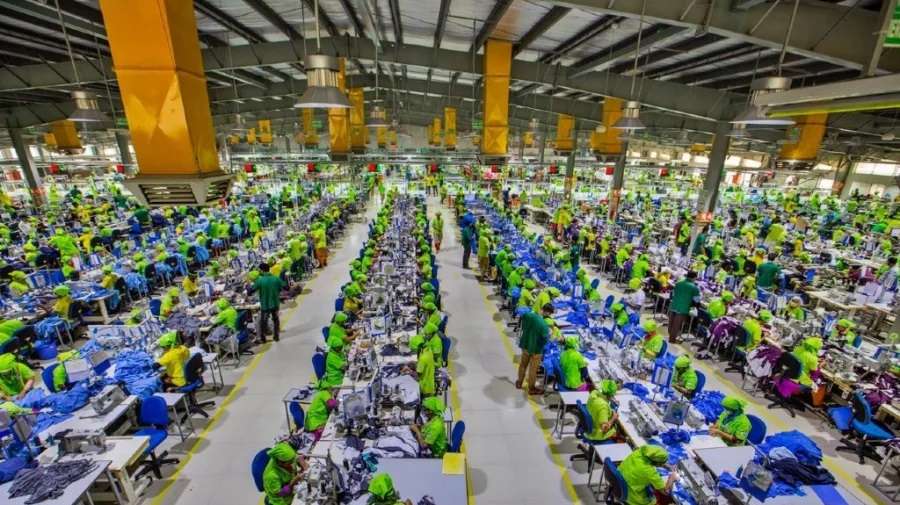
 With manufacturing costs rising in China, and the recent mishaps in Bangladesh India seems to have a better future as a world sourcing hub. However, Harry van Dalfsen, President IAF feels India still has a long way to go. As Bangladesh’s extremely low labour costs play a role and China’s one stop shop ease of doing business still scores. However, the root causes are diverse and complex.
With manufacturing costs rising in China, and the recent mishaps in Bangladesh India seems to have a better future as a world sourcing hub. However, Harry van Dalfsen, President IAF feels India still has a long way to go. As Bangladesh’s extremely low labour costs play a role and China’s one stop shop ease of doing business still scores. However, the root causes are diverse and complex.
Further talking about how Europe and the US are looking at current dynamic apparel sourcing scenario apparel from Asia Dalfsen says “We have coined the term '2nd phase post MFA sourcing’. That is, after the disappearance of quota, China has rapidly attained its current dominance in apparel production, but now, in view of rising costs and sluggish markets, especially in the west, again a period of relatively big chance in sourcing patterns is taking place. There are some real movements out of China, especially into Bangladesh and some smaller moves into location closer by the markets (such as Turkey for Europe) and also brands and retailers are actively looking in places they weren’t before (Birma, Africa).”
Ever evolving China
Talking about how China’s role has changed Dalfsen, says, “Remember that only 30 years ago, its role on the world scene was negligible. Then it became the production powerhouse and now as the retail market for fashion is fast becoming more mature.” According to Dalfsen, entering the Chinese market as a European brand for instance is easier said than done. But also vice versa, building a brand in China and selling in the US, EU, India, ASEANor other markets is a huge challenge.
Dalfsen feels Europe especially many medium sized brands (about € 50 million turnover on average) that are strong in their home markets still have to start exporting to another continent such as to China. However, now it has been observed that department stores and multi-brand stores from China are actively travelling to Europe and the US to find good medium sized brands.
IAF's role as a manufacturers' federation
Bangladesh has emerged as the second largest country for sourcing but recent events there forced European and US brands to rethink. Explaining this further Dalfsen opines, “The European Accord and the US Alliance on worker safety in Bangladesh have quickly allowed for firms to stay in Bangladesh while at the same time communicating that they are actively participating in the prevention of these tragedies. So I think we will not see a big drop in exports of apparel from Bangladesh.”
While IAF cannot and legally may not get involved in pricing, Dalfsen feels that the focus in global responsibility is shifting from compliance to real improvements. These improvements must be common investments occurring in the entire supply chain. ”On the other hand, few other industries are so fragmented and competitive and this is of course reflected in fights for margin within the supply chain,” he sums up.
The All-Pakistan Textile Mills Association (APTMA) would launch a new initiative from January 1, 2014, to improve the image of Pakistan’s textiles around the world. The aim is to double the industry’s exports to $26 billion over the next three to four years in the wake of free market access from the European Union. APTMA has decided to adopt the triple bottom line concept –a corporate social responsibility strategy that focuses on people, planet and profits – as a part of its social corporate responsibility program to launch a soft image of Pakistan globally.
APTMA is engaging all its members to ensure the welfare of its workers including health, safety and education of their children. It has already established a sustainability cell that ensures efficient use of energy and conservation of water. Mills are being asked to ensure that they treat and conserve water to protect the environment.
In time APTMA will encourage the entire textile chain to adopt the triple bottom line concept. There would be textile shows in the United States and the European Union to promote Pakistani textile products and a soft image of the country.
For the first time in three years, textile mill owners have seen their concerns about supply of power and energy adequately addressed and 90 per cent of the textile mills are operating at full capacity.
Pakistan’s export of textile and clothing products witnessed a double digit growth in the first month of the current fiscal year compared to a year ago. Exports witnessed a double digit growth because of an increase in exports to European markets owing to preferential market access on selected products. The European Union preferential package on import of 75 items has been in operation since December 2012.
Export of textile and clothing surged to $1.136 billion in July 2013 from $1.090 billion in the corresponding month last year. Textile and clothing products, which witnessed a negative growth, are cotton carded and yarn other than cotton yarn in July 2013 over the same month last year.
However, growth in exports in July was mainly driven by knitwear, bed wear, towels and readymade garments, which are valued-added products. Growth in yarn and fabric exports was mainly because of improved energy supply. The full capacity utilisation of production caused growth in the export of home textiles — towels and bed wear as well.
Raw cotton exports from Pakistan have slumped in quantity terms and value terms. But this fall in raw cotton exports is seen as a boon. Reduced exports would also help in stabilizing cotton prices at home which are higher than international prices. The Pakistani textile industry each year falls short of around three million bales of cotton against its total demand for around 16 million bales.
At least 2,000 garment factories in Bangladesh will be inspected in the month of September. The government-led National Tripartite Action Plan on Building and Fire Safety, which is working with employers and worker groups and the International Labour Organization (ILO), say teams led by the Bangladesh University of Engineering and Technology (BUET) will undertake the assessments. There are also plans to set out a national standard for fire safety and structural assessments as a benchmark for all audits to meet. The Bangladesh Garment Manufacturers and Exporters Association (BGMEA) has pledged to share documents related to factory design and layout with the Committee, which will also share the national standards with all relevant stakeholders at a workshop on September, 7.
The National Tripartite Committee was set up in response to the fire at Tazreen Fashion last November and the collapse of the Rana Plaza building in April which led to the loss of more than 1,200 lives. There are also concerns that Bangladesh's Ministry of Labor is struggling to recruit the 200 factory inspectors it requires. The ILO reveals just four inspectors have been recruited so far, with another 72 due to be on board by October. The recruitment process for another 128 inspectors will begin in November.
Separate schemes are also underway by the North American Alliance for Bangladesh Worker Safety with its Bangladesh Worker Safety Initiative, and the European Accord on Fire and Building Safety in Bangladesh - which between them intend to examine at least 1,500 factories.
They will also offer funds and assistance with remedial action including the relocation and rebuilding of unsafe factories and have set a timeframe to see all their supplier factories inspected within the next nine months to one-year.
Punjab’s chief minister Muhammad Shahbaz Sharif has announced special incentives for local and foreign investors in the garments industrial zone. Issuing instructions for setting up a committee for identifying the site for the establishment of Punjab China Industrial Zone, the CM has directed that the committee should present its report within seven days after consulting all stakeholders so that the project could be initiated without any delay. The committee will comprise senior member board of revenue, secretary industries and representatives of Punjab Industrial Estate Development and Management Company.
Prominent industrialists associated with the garments sector applauded Sharif’s steps taken for the development of garments industry and said that due to the personal interest taken by the chief minister not only garments industry would make rapid progress but huge foreign exchange would also be earned.
The chief minister said that setting up of Punjab China Garments Industrial Zone on a large piece of land near motorway should be considered while other locations for this purpose should also be identified and a report be submitted within seven days. The minister also issued instructions for constituting a working group to remove hurdles in the establishment of the industrial zone and directed that the working group should immediately formulate its recommendations so that the concerned institutions could be contacted for removing impediments. He said that working group should meet on weekly basis and propose steps expeditiously in this regard.
Taiwanese companies that attended a fashion trade exhibition in Las Vegas are expected to obtain about $5 million worth of orders, the Taiwan Textile Federation (TTF) said. As per TTF, 16 textile exporters from Taiwan displayed readymade clothing, hats, socks and other accessories to potential foreign buyers at the Las Vegas Magic Show 2013 from August 18-21, a private sector group. High performance fabric supplier AGT International, ladies woven apparel maker Caribbean Industrial, and sports socks exporter Danken Enterprise were among the exhibitors at the Taiwan pavilion, the group said.
Under the theme ‘Think Taiwan for Textiles,’ the pavilion attracted many international brands such as Adidas, bebe, Marubeni America Corp, JLux Concepts, and Beachbody. These international brands held discussions with the Taiwanese companies and are likely to place at least S$5 million worth of orders for Taiwan-made products, the TTF said.
Yang Hsiao-chin, a section chief at the TTF said the federation is determined to offer local manufacturers the necessary assistance to set up a distribution network in US cities, particularly in Los Angeles as it is a gateway to the huge New York market and Latin America. The TTF is planning to hold similar trade shows and meetings in Indonesia and Vietnam in early November in a bid to help local exporters penetrate the global market, said Chin.
A resurgence demand from China for cotton yarn has boosted India’s export, which has gone up by 55 per cent in the first four months of the current financial year. If the trend continues, cotton yarn exports will likely hit a new record this year.
“If the trend continues, cotton yarn exports would beat all previous expectations to set an all time record this year,” says D K Nair, Secretary General, Confederation of Indian Textile Industry. Reports reveal the Cotton Yarn Advisory Board has projected a marginal 14.2 per cent increase to 1,150 million kg in cotton yarn exports from India this financial year. But actual exports could be even higher. Total cotton yarn production this year is estimated at 4,000 million kg. “The substantial increase in exports, however, has not affected domestic supply to mills at all. Domestic mills are operating smoothly with adequate capacity,” said Nair.
Further the exponential growth in cotton yarn shipment has lowered the prospects of cotton exports as Chinese importers find purchase of fibre cost effective. Another factor which helped exports is the record depreciation in the rupee against the dollar. Exporters have rushed to sign a pact with importers at the current exchange rate and lock in till exports are executed. Also, cotton prices have jumped 11.79 per cent to trade at Rs 13,329 a quintal mid August against Rs 11,923 a quintal a month ago.
Intertek, a leading provider of quality and safety services to a wide range of industries around the world, has opened a new apparel and textiles testing laboratory in Hanoi to support the growing textile and garment industry in the northern Vietnam. The new facility occupies more than 6,000 sq. ft. and is fully equipped with state-of-the-art equipment combined with highly qualified engineers and chemists to provide reliable quality and safety solutions. The new lab performs textile testing for dimensional stability, colour fastness and seam strength, among others. The lab also supports full testing capabilities to US Consumer Product Safety Improvement Act (CPSIA) requirements and restricted substances regulations.
Thanh Nam Nguyen, General Manager for Softlines, Hardlines and Toys business lines, said, “The addition of the Hanoi facility aligns with Intertek’s continuous effort to provide a local presence for our customers, wherever their business operations are located. This provides a distinct competitive advantage in an industry where getting safe and high-quality products to market is imperative for success.”
The Hanoi apparel testing laboratory is the most recent addition to Intertek’s global network of 45 textile and footwear laboratories that serve fabric, apparel, fashion accessory, home textile and footwear retailers, brands and manufacturers. In addition to testing, Intertek offers the following services for textile, footwear and apparel customers: chemical management, inspections, certification, auditing, safety and compliance training, outsourcing and advisory, quality assurance and risk management.
Kuruwita Textile Mills, a unit of Sri Lanka's Brandix Apparel group reported exports to Bangladesh rose in June 2013 quarter. However, the company’s looses increased amid increasing costs. The firm lost Rs 211 million in the quarter up 355 per cent from a year ago period. It reported losses of Rs 8.46 per share in accounts filed with the Colombo Stock Exchange.
Kuruwita Textiles said revenues rose 11 per cent to Rs 1.82 billion in the June quarter, but expenses rose at a faster rate at 23 per cent to Rs 1.98 billion, a gross loss of Rs 157 million against a profit of Rs 44.7 million a year earlier. Exports to Bangladesh had grown to 41 per cent of sales in the June quarter up from 31 per cent last year. "However, it has to be noted that the Bangladeshi orders carry comparatively lower margins due to the lower average selling prices partly due to the effects of the off season for the company’s product range," Chairman Aslam Omar told shareholders.
He said raw material costs were 15 per cent higher than last year but they could not be passed on fully with higher selling prices. Electricity costs were also higher. "The management has been actively looking at mitigating these adverse impacts and is currently reviewing alternatives," Omar said without elaborating.
Major textile manufacturers in Japan have been entering the field of clothing design and manufacturing, aiming to increase profitability through business expansion by supplying products to general merchandisers and boutiques, where they are sold under private labels. In mid-June, Osaka-based Teijin Frontier held a spring/summer fashion preview for retailers, where a wide range of products, including women’s casual wear and men’s suits, were on display. In addition to showing off fabrics with deodorant, cooling, stretch and other features, the company highlighted the cutting-edge technologies used to make their products, such as a special fibre that gives garments a unique texture.
Toray Industries embarked on full-fledged manufacturing of finished apparel around 2006 and became a textile industry pioneer for its entry into a downstream business. The expansion trend among major textile makers has been partly inspired by Uniqlo’s business model. Uniqlo has grown into a self-styled manufacturing retailer, handling all aspects of production from planning to manufacturing and selling. Meanwhile the company has avoided price competition by launching products with innovative features such as heat-tech, a line of heat-generating underwear.
With Unitika considering producing kids’ clothes and Daiwabo Holdings eyeing the casual wear market, textile makers are expected to continue making waves in the apparel business.












